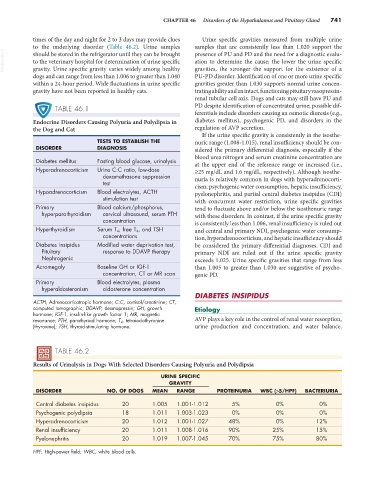Page 769 - Small Animal Internal Medicine, 6th Edition
P. 769
CHAPTER 46 Disorders of the Hypothalamus and Pituitary Gland 741
times of the day and night for 2 to 3 days may provide clues Urine specific gravities measured from multiple urine
to the underlying disorder (Table 46.2). Urine samples samples that are consistently less than 1.020 support the
VetBooks.ir should be stored in the refrigerator until they can be brought presence of PU and PD and the need for a diagnostic evalu-
ation to determine the cause; the lower the urine specific
to the veterinary hospital for determination of urine specific
gravity. Urine specific gravity varies widely among healthy
PU-PD disorder. Identification of one or more urine specific
dogs and can range from less than 1.006 to greater than 1.040 gravities, the stronger the support for the existence of a
within a 24-hour period. Wide fluctuations in urine specific gravities greater than 1.030 supports normal urine concen-
gravity have not been reported in healthy cats. trating ability and an intact, functioning pituitary vasopressin-
renal tubular cell axis. Dogs and cats may still have PU and
TABLE 46.1 PD despite identification of concentrated urine; possible dif-
ferentials include disorders causing an osmotic diuresis (e.g.,
Endocrine Disorders Causing Polyuria and Polydipsia in diabetes mellitus), psychogenic PD, and disorders in the
the Dog and Cat regulation of AVP secretion.
If the urine specific gravity is consistently in the isosthe-
TESTS TO ESTABLISH THE nuric range (1.008-1.015), renal insufficiency should be con-
DISORDER DIAGNOSIS sidered the primary differential diagnosis, especially if the
blood urea nitrogen and serum creatinine concentration are
Diabetes mellitus Fasting blood glucose, urinalysis at the upper end of the reference range or increased (i.e.,
Hyperadrenocorticism Urine C:C ratio, low-dose ≥25 mg/dL and 1.6 mg/dL, respectively). Although isosthe-
dexamethasone suppression nuria is relatively common in dogs with hyperadrenocorti-
test cism, psychogenic water consumption, hepatic insufficiency,
Hypoadrenocorticism Blood electrolytes, ACTH pyelonephritis, and partial central diabetes insipidus (CDI)
stimulation test with concurrent water restriction, urine specific gravities
Primary Blood calcium/phosphorus, tend to fluctuate above and/or below the isosthenuric range
hyperparathyroidism cervical ultrasound, serum PTH with these disorders. In contrast, if the urine specific gravity
concentration is consistently less than 1.006, renal insufficiency is ruled out
Hyperthyroidism Serum T 4, free T 4 , and TSH and central and primary NDI, psychogenic water consump-
concentrations tion, hyperadrenocorticism, and hepatic insufficiency should
Diabetes insipidus Modified water deprivation test, be considered the primary differential diagnoses. CDI and
Pituitary response to DDAVP therapy primary NDI are ruled out if the urine specific gravity
Nephrogenic exceeds 1.025. Urine specific gravities that range from less
Acromegaly Baseline GH or IGF-1 than 1.005 to greater than 1.030 are suggestive of psycho-
concentration, CT or MR scan genic PD.
Primary Blood electrolytes, plasma
hyperaldosteronism aldosterone concentration
DIABETES INSIPIDUS
ACTH, Adrenocorticotropic hormone; C:C, cortisol/creatinine; CT,
computed tomographic; DDAVP, desmopressin; GH, growth Etiology
hormone; IGF-1, insulin-like growth factor 1; MR, magnetic
resonance; PTH, parathyroid hormone; T 4 , tetraiodothyronine AVP plays a key role in the control of renal water resorption,
(thyroxine); TSH, thyroid-stimulating hormone. urine production and concentration, and water balance.
TABLE 46.2
Results of Urinalysis in Dogs With Selected Disorders Causing Polyuria and Polydipsia
URINE SPECIFIC
GRAVITY
DISORDER NO. OF DOGS MEAN RANGE PROTEINURIA WBC (>5/HPF) BACTERIURIA
Central diabetes insipidus 20 1.005 1.001-1.012 5% 0% 0%
Psychogenic polydipsia 18 1.011 1.003-1.023 0% 0% 0%
Hyperadrenocorticism 20 1.012 1.001-1.027 48% 0% 12%
Renal insufficiency 20 1.011 1.008-1.016 90% 25% 15%
Pyelonephritis 20 1.019 1.007-1.045 70% 75% 80%
HPF, High-power field; WBC, white blood cells.

